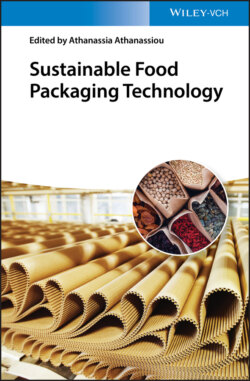Читать книгу Sustainable Food Packaging Technology - Группа авторов - Страница 40
2.3.2 Preparation and Characterization of Chitosan Films and Coatings
ОглавлениеChitosan‐based materials can be prepared employing two different processes known as wet or dry techniques. The wet method is the most most employed process when using this polysaccharide because it is a versatile technique [112]. During this process, chitosan is dissolved in acidified water since it is insoluble in basic media [113, 114]. After heating and stirring the solutions, films can be obtained by solution casting and drying, or food coatings can be prepared by spraying or dipping [115, 116]. On the other hand, few works related to dry process to prepare chitosan films have been reported in the literature. Galvis‐Sánchez et al. [117] prepared chitosan films by thermal compression. First, chitosan powder was mixed with natural deep eutectic solvents, such as citric acid or lactic acid. The mixture was introduced in an oven at 80 °C for 30 minutes and then an acetic acid solution was added during manual mixing. The resultant mixture was introduced in a hydraulic press and thermo‐compressed. In another work, Guerrero et al. [118] thermo‐compressed citric acid–chitosan films at 125 °C for two minutes, using glycerol as plasticizer. Chitosan has also been compressed after blending with other polysaccharides such as starch. Valencia‐Sullca et al. [119] dispersed chitosan, starch, glycerol, and polyethylene glycol in water and the mixture was melt blended at 160 °C for 30 minutes until a homogeneous paste was obtained before processing by thermal compression.
After preparing chitosan films and coatings, material characterization must be carried out in order to know their suitability for the specific application of food packaging. Mechanical properties are one of the most important parameters of the characterization. Mechanical behavior determines whether the film or coating is suitable for the packaging purpose since it has to support mechanical loads during the logistic process to keep the product intact and avoid food deterioration [120]. Unmodified chitosan films are brittle due to the electrostatic interactions and hydrogen bonding between chitosan chains. Hence, plasticizers are used to lend chitosan better mechanical properties, to provide chitosan chains with mobility, and, thus, increase flexibility. Among plasticizers, glycerol is the most employed in chitosan films [102].
In relation to water‐related properties, these are of interest to define which kind of product can be packaged. Since chitosan films and coatings present moderate values of water resistance due to the presence of hydrophilic groups (–OH and –NH2) [113], chitosan properties are modified employing different additives. Wang et al. [121] studied chitosan films enriched with anthocyanins at different concentrations (5%, 10% and 15% by weight based on the chitosan dry basis). Regarding moisture content, this value decreased with the increase of anthocyanin concentration due to the intermolecular interactions by hydrogen bonding between anthocyanins and the hydrophilic groups of chitosan. Concerning water vapor permeability, anthocyanin‐added chitosan films exhibited lower values due to the more compact structure formed as a consequence of the interactions between anthocyanin and chitosan.
